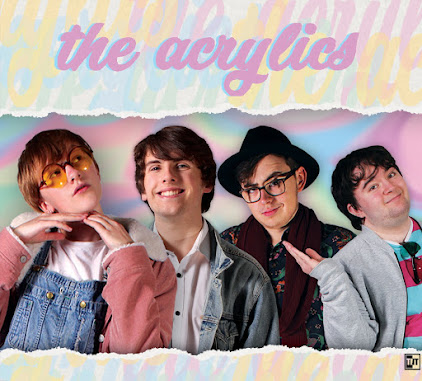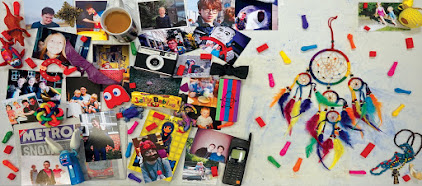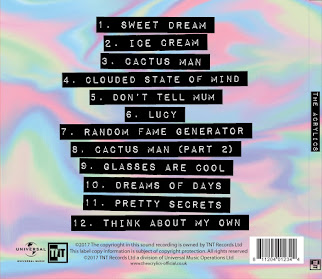Cage the Elephant's "Back Against The Wall" from their eponymous debut album. They are on of my favourite artists, and this is their most rock-leaning album- in this song you can hear the drums and fingers on the guitar strings and so on, very typical of rock. It already has a touch of the alternative rock that they eventually turn towards, especially in the slow start and fairly interesting lyrics, but overall it is very rock influenced, especially in comparison to the next song I will present. Click to play.
Cage the Elephant's "Telescope" from their third album "Melophobia." At this point, they have developed from a rock band which dabbles in garage and alternative rock to a full-blow alternative rock band. The album's title means fear of music, which they describe as the fear of making regular (and thus standard rock) music, and this song features lyrics inspired by the lead singer's depression. The instruments have evolved to accommodate this new direction, with a xylophone-sounding instrument at the beginning and a softer feel throughout. Click to play.
The look of alternative rock artists is also a bit different than regular rock artists. While both set out to be stylish and good-looking, an alternative rock performer might lean more towards a look that could be described as 'hipster,' whereas the regular rock performer would probably draw on mainstream fashion as well as rock history for their look. This opens up lots of opportunities for our artist's fashion sense, since 'hipster' is defined as being a bit more interesting and away from mainstream fashion while still looking conventionally stylish. The genre's look overall also tends more towards the strange, allowing alternative rock artists to do effectively whatever they want in their music videos- the only limit is that they tend to try and stay with the lyrics, using the music video as a way of amplifying or even just representing the lyrics' meaning, as Goodwin described in his theories.
Alternative rock took off the the 1980s, being influenced both by the counter-culture of punk and punk rock music of the 1970s and of course the ever-popular rock genre. As a result, alternative rock is really just a mish-mash of slightly different subgenres that all want to be somewhat distinct from the main genre of rock. By the end of the 1980s, different styles of alternative rock taking inspiration from all kinds of genres were popular, but in the 1990s Nirvana emerged as a huge success, taking influence from one of their more popular contemporaries/predecessors, R.E.M., and made alternative rock mainstream. Mostly alternative rock stayed somewhat independent however, leading to the subgenre's grouping with indie rock in the 2010s, despite a brief revival in the 2000s.
Another genre I think would be interesting for our song selection is Electro Swing. It is quite a strange genre that nevertheless has a not insignificant following, that combines the style and even themes of early 20th century music with the technology of today. This results in quite an interesting and varied sound- some electro swing songs could not be told apart from a normal swing song from the 1920s or '30s (and even '40s,) excepting sound quality, and others incorporate instruments and effects seen in modern electronic music to set themselves apart from other songs. This mix of old and new, as well as the theme of the music itself, are common throughout the genre's music, both sound-wise as well as in the lyrics and ideas of the songs.
"It Don't Mean a Thing (If It Ain't Got That Swing,)" written in 1931, played as a collaboration between two famous swing musicians, Louis Armstrong & Duke Ellington. The brass instruments, wide variety of traditional instruments, lyrics talking about the music itself, instrumental solos, and scat are all pretty typical of the genre.
"Empires" by Electric Swing Circus, from their 2017 album "It Flew By." While the song doesn't reference swing music, the band's name does, as typical of the genre and seen in the previous song I referenced. The brass instrumentation is still present, as are the solos (especially trumpet, as before,) and scat, and as a modern twist drums are quite prominent.
The artists allow the fashions of the early 20th century to inspire them, but with a modern dress. Men could dress up in suits but adopt the more casual look of the modern day by losing the jacket, and women could wear the stereotypical 'flapper' dress and headband but modernise it by making the dress less restrictive, for example. Anything from the influential time period is fair game here, basically, and this would really benefit us when creating our own artist- we have a huge and obvious pool of inspiration, but it's open enough that we have a huge range or choices that we can put a modern spin on.
 |
| Ella Fitzgerald, a popular female swing artist, wearing a feathery hat (as feathers were popular back then) and a dress with a V-neck, mostly plain but with a nice pattern. Click to enlarge. |
One final genre that we could choose is Indie Pop. As a subgenre of pop it has a large following, being a “popular” genre, and thus has an expansive history to draw on musically and otherwise. From older artists like The Smiths to modern artists like Bastille, indie pop has, musically and otherwise, evolved over time a fair amount, more so than other genres, probably owing to its link to pop music and the fact that what is popular is constantly changing, but it has always managed to remain in the mainstream- you may have noted the popularity of the two bands I used as examples in their respective time periods. The sound is similar to pop in that it is often fairly simple but always catchy, and similar to indie music in that it deals with deeper themes that are closer to the artists' hearts, that they can make music about as they are not as constrained by the industry.
A song popular even in the pop genre, "All About That Bass" by Meghan Trainor. Note the simple but catchy beats, frequent choruses, and upbeat but somewhat sexualised lyrics encouraging people to not worry about their bodies and body image in an entertaining way. It is quite a typical example of pop music that is designed for casual and enjoyable listening.
"Girlfriend in a Coma" by The Smiths. A much older song than the previous one, and this time indie pop. Once again the instrumentation is catchy and upbeat, and their are frequent choruses and repetitions of certain lines. However, unlike the positive body image themes of "All About That Bass," this song deals with someone who used to have fights with their girlfriend (implied to be violent in some places,) but still loves her, and now she is in a coma and could die soon. This change of tone while adhering to pop conventions is one of the markers of indie pop.
The look of indie pop could probably be summed up as 'quirky.' This is because it takes a lot of cues from what is fashionable in the mainstream, but strays a little bit out of the spotlight as the artists put their own spin on it. So you will see the artists in the popular brands and/or with a strong sense of style, but maybe with a scarf or a colour scheme that you wouldn't usually see. The genre overall also tends to follow this pattern, with indie pop music videos being generally more colourful and interesting than a standard pop video, but otherwise very similar. I think this would benefit us as we could look at the standard conventions of music videos and then just put our own unique spin on them.
 |
| Meghan Trainor, a pop artist, wearing makeup and a leather jacket with styled hair to look good in a promotional shot. Click to enlarge. |














No comments:
Post a Comment